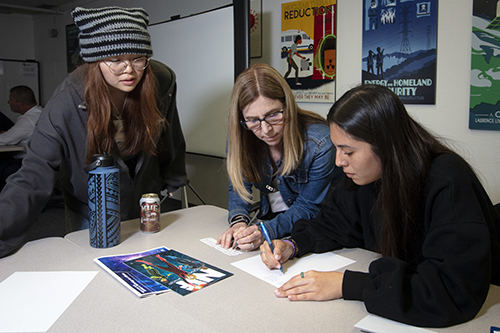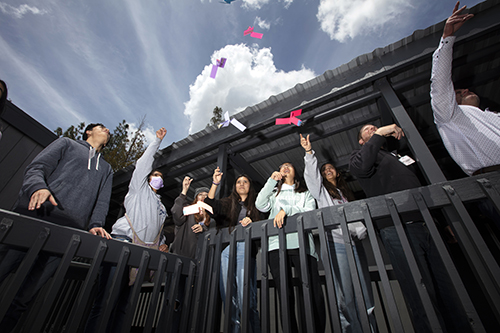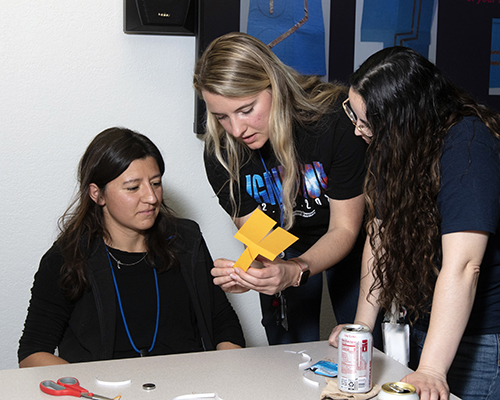Girls Who Code ‘Altamont Connection’ brings students from Livermore and Tracy to the Lab
 (Download Image)
(Download Image)
High school students from Livermore and Tracy work against the clock to decipher a PIN code to unlock a safe deposit box at the Altamont Connection Girls Who Code event on May 5. Photos by Randy Wong/LLNL.
High school students from Livermore and Tracy visited Lawrence Livermore National Laboratory (LLNL) on May 5 for a first-of-its kind event bringing the two cities’ Girls Who Code (GWC) programs and others together on-site for group activities and tours under a new “Altamont Connection” moniker.
The event, which included tours of the National Ignition Facility, Discovery Center and Advanced Manufacturing Laboratory, gave about a dozen students from the two school districts the opportunity to see science in action and interact face-to-face with Lab computer scientists and mentors they’d engaged with throughout the school year.
“These students have been working all year on coding in these afterschool clubs, and now they get to come and meet other kids that also have been doing that same work,” said Dean Reese, director of STEM curriculum for the Tracy Unified School District. “They're building a network with other like-minded kids in this region, and they're getting access to national laboratory science and understanding what this great lab is doing. They are seeing role models in their field and interacting with interns that then became employees of the Lab. I think that gives them an example of what's possible.”
After lunch, students from Tracy, West and Kimball high schools in Tracy joined with students from Livermore’s Granada High School at the Livermore Valley Open Campus, where they decrypted ciphers to crack safes full of treats and created their own battery-powered, LED-lighted helicopters. Kimball High School senior Maili Malabey said it was her first time visiting the Lab since a field trip in the fifth grade. After graduation, Malabey will be returning to the Lab this summer as an intern in Computing. She said the visit was a bit “overwhelming,” but gave her a good idea of what to expect.
Kimball High School Girls Who Code teacher adviser Lynda Lawrence (center) assists Kimball High seniors Chloe La and Maili Malabey as they try their hand at decrypting ciphers.“It's really cool to see all the progress the Lab has made over the years, and it really inspires me, because I hope that I can help with that progress over this summer,” she said. “It is a little intimidating, but everyone I’ve met here has been super kind to me and I can't wait to meet more people here.”
Granada High School freshman Shirley Liang said she joined Girls Who Code this year, where she found a “very supportive community” that included learning from her Lab mentors.
“Honestly [this visit] has been a lot of information,” Liang said. “When I came here in middle school, they took us in the Discovery Center and let us look around. But now they're giving us tours and it's really eye-opening to see everything that's happening here. It's really cool.”
Girls Who Code is a global nonprofit organization dedicated to closing the gender gap in technology and computer science, with a goal of inspiring more girls to become computer scientists and engineers. The organization has facilitated computer programming training for about a half-million girls, women and nonbinary individuals worldwide, according to the GWC website.
LLNL’s involvement with GWC began in 2016 as a collaboration between the national program, the Livermore Valley Joint Unified School District and the Lab, before expanding into Tracy in 2021. During the school year, once a week for the duration of the school year, Lab volunteers from an array of disciplines provide training and curriculum to local GWC clubs, meeting with students and partnering with club advisers to teach computer science, engineering and coding and helping to develop enrichment activities. The schools provide the facilities, equipment and a teacher to help coordinate the activities.
The Altamont Connection Girls Who Code students test their DIY light-up helicopters outside Lawrence Livermore National Laboratory’s Discovery Center on May 5.LLNL’s GWC outreach currently impacts about 180 students in the Livermore and Tracy school districts, according to Computing Workforce Administrator Jamie Lewis, an organizer for the event. Lewis said the program is focused on strengthening the workforce pipeline between the Lab and the local high schools, particularly among young women interested in STEM careers, with the “Altamont Connection” effort being the latest example of the program’s expansion.
“We tried to keep it really simple at first,” Lewis explained. “Bringing the districts here and having a day together is something we’ve always talked about and are now actually seeing happen. And today, we were lucky enough to have some of the space and engineering groups from Tracy join us, so it’s really exciting to see the broad reach that this [program] has had.”
Computing Workforce Manager Marisol Gamboa said she was impacted by a similar program to GWC at age 15, the first time she touched a computer, learned to program and became “hooked for life.”
“Activities like this strengthen our relationship with those in the community and provides our employees the opportunity to impact and make a difference in young people's lives all while building a future pipeline for the Lab,” Gamboa said.
Volunteer Girls Who Code mentors and LLNL software developers Paige Jones (middle) and Mariah Martinez (right) help a student create her helicopter.Volunteer mentors and Lab software developers Mariah Martinez and Paige Jones designed the codebreaking and helicopter activities, and said they were both “passionate about giving back.” Each Monday during the school year, the pair visits Mendenhall Middle School’s GWC club to teach programming concepts and design activities based on the GWC curriculum.
Martinez came to the Lab originally in 2016 through the Cyber Defenders summer program as a Las Positas College student and returned later to the Lab as an intern, where she credits her LLNL mentors with helping her decide her career path. Martinez said she hoped the day’s enrichment activities encouraged the students to collaborate with people they wouldn’t normally interact with and exposed them to the growing field of cybersecurity.
“It’s big for kids to get introduced to this type of thing early on, and especially to be aware of how all the different STEM fields can be related to each other and influence each other,” Martinez said. “In school, students tend to kind of get siloed into the classes and just focus on that specific class and how it's relevant to that class. And here at the Laboratory, we see every single day that we are a mix of all these different STEM fields working together for one purpose, and that's what we hope to bring with our activities, bringing a lot of different aspects that the kids can kind of take, run with and learn something from.”
Jones’ interest in student outreach began while she was in college, where she started an Association for Computing Machinery women’s engineering group that partnered with middle and high schools on STEM activities. Jones said she felt the Altamont Connection event was an important opportunity for exposing students from outside Livermore to the Laboratory.
“It’s really good to have collaboration between the Livermore and Tracy schools and to open that door, because I think while a lot of people know the Lab’s name, they don't really know what we do,” Jones explained. “To be able to bring students that aren't physically as close and showing them the facilities and what we do and allowing them to collaborate with students here in Livermore, I think is really important. Creating a pipeline for students and piquing their interests and inspiring them with their activities, that's the goal.”
The event was coordinated by LLNL Science Education Manager Joanna Albala, Business Operations Specialist for Academic Engagement Office Mildred Lambrecht and Lewis and Nikki Finnestead from the Computing Workforce office.
Lewis said there are plans to bring the Altamont Connection GWC group, including middle school students, back to the Lab in the fall.
Contact
 Jeremy Thomas
Jeremy Thomas
[email protected]
(925) 422-5539
Related Links
Girls Who CodeTags
ASCHPC, Simulation, and Data Science
Computing
Engineering
Community Outreach
Featured Articles










